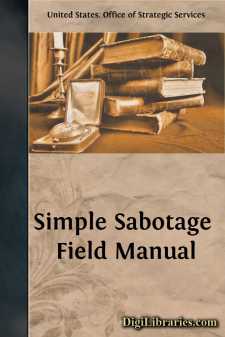Categories
- Antiques & Collectibles 13
- Architecture 36
- Art 48
- Bibles 22
- Biography & Autobiography 813
- Body, Mind & Spirit 142
- Business & Economics 28
- Children's Books 17
- Children's Fiction 14
- Computers 4
- Cooking 94
- Crafts & Hobbies 4
- Drama 346
- Education 46
- Family & Relationships 57
- Fiction 11829
- Games 19
- Gardening 17
- Health & Fitness 34
- History 1377
- House & Home 1
- Humor 147
- Juvenile Fiction 1873
- Juvenile Nonfiction 202
- Language Arts & Disciplines 88
- Law 16
- Literary Collections 686
- Literary Criticism 179
- Mathematics 13
- Medical 41
- Music 40
- Nature 179
- Non-Classifiable 1768
- Performing Arts 7
- Periodicals 1453
- Philosophy 64
- Photography 2
- Poetry 896
- Political Science 203
- Psychology 42
- Reference 154
- Religion 513
- Science 126
- Self-Help 84
- Social Science 81
- Sports & Recreation 34
- Study Aids 3
- Technology & Engineering 59
- Transportation 23
- Travel 463
- True Crime 29
Simple Sabotage Field Manual
Categories:
Description:
Excerpt
1. INTRODUCTION
The purpose of this paper is to characterize simple sabotage, to outline its possible effects, and to present suggestions for inciting and executing it.
Sabotage varies from highly technical coup de main acts that require detailed planning and the use of specially-trained operatives, to innumerable simple acts which the ordinary individual citizen-saboteur can perform. This paper is primarily concerned with the latter type. Simple sabotage does not require specially prepared tools or equipment; it is executed by an ordinary citizen who may or may not act individually and without the necessity for active connection with an organized group; and it is carried out in such a way as to involve a minimum danger of injury, detection, and reprisal.
Where destruction is involved, the weapons of the citizen-saboteur are salt, nails, candles, pebbles, thread, or any other materials he might normally be expected to possess as a householder or as a worker in his particular occupation. His arsenal is the kitchen shelf, the trash pile, his own usual kit of tools and supplies. The targets of his sabotage are usually objects to which he has normal and inconspicuous access in everyday life.
A second type of simple sabotage requires no destructive tools whatsoever and produces physical damage, if any, by highly indirect means. It is based on universal opportunities to make faulty decisions, to adopt a noncooperative attitude, and to induce others to follow suit. Making a faulty decision may be simply a matter of placing tools in one spot instead of another. A non-cooperative attitude may involve nothing more than creating an unpleasant situation among one's fellow workers, engaging in bickerings, or displaying surliness and stupidity.
This type of activity, sometimes referred to as the "human element," is frequently responsible for accidents, delays, and general obstruction even under normal conditions. The potential saboteur should discover what types of faulty decisions and the operations are normally found in this kind of work and should then devise his sabotage so as to enlarge that "margin for error."
2. POSSIBLE EFFECTS
Acts of simple sabotage are occurring throughout Europe. An effort should be made to add to their efficiency, lessen their detectability, and increase their number. Acts of simple sabotage, multiplied by thousands of citizen-saboteurs, can be an effective weapon against the enemy. Slashing tires, draining fuel tanks, starting fires, starting arguments, acting stupidly, short-circuiting electric systems, abrading machine parts will waste materials, manpower, and time. Occurring on a wide scale, simple sabotage will be a constant and tangible drag on the war effort of the enemy.
Simple sabotage may also have secondary results of more or less value. Widespread practice of simple sabotage will harass and demoralize enemy administrators and police. Further, success may embolden the citizen-saboteur eventually to find colleagues who can assist him in sabotage of greater dimensions....


